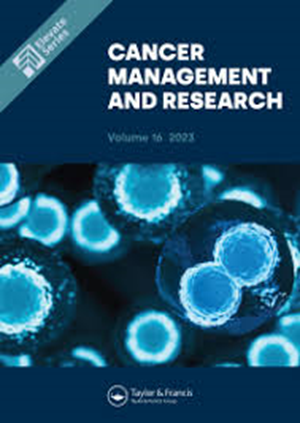透骨草参附汤通过抑制 TGF-β/SMAD 通路提高雌激素受体阳性乳腺癌对他莫昔芬的敏感性
IF 2.6
4区 医学
Q3 ONCOLOGY
引用次数: 0
摘要
背景:内分泌治疗耐药可导致乳腺癌(BC)复发和转移,影响患者的生存期。传统中药 "天干地支汤 "已被广泛应用于雌激素受体阳性(ER+)乳腺癌的治疗。然而,TGBSXJ方治疗ER+BC的内在机制尚未完全阐明:方法:利用网络药理学(NP)和 RNA 测序预测 TGBSXJ 方剂的候选成分并探索其潜在靶点。方法:采用网络药理学(NP)和 RNA 测序方法预测 TGBSXJ 方剂的候选成分并探索其潜在靶点,然后通过体外实验研究 NP 和 RNA 测序的结果:结果:TGBSXJ 方剂的有效成分主要包括芒果苷、芦丁、天南星皂苷 BII、灵芝酸 A 和乙酰乙酸等。根据 TGBSXJ 方剂的有效成分和 ER+ BC 的靶基因建立了蛋白-蛋白相互作用(PPI)网络,其中 TGF-β、MMP2 和 SMAD3 被定义为中心基因。体外实验表明,TGBSXJ 方剂能显著抑制 ER+ BC 细胞的活力、集落能力和迁移,并能显著提高其对 TAM 的敏感性。Western印迹分析表明,TGBSXJ配方能明显下调ER+ BC细胞中的TGF-β、E-cadherin、MMP2、MMP9、N-cadherin、p-Smad2和p-Smad3:结论:TGBSXJ配方通过抑制TGF-β/Smad信号通路提高了ER+ BC细胞对TAM的敏感性。本文章由计算机程序翻译,如有差异,请以英文原文为准。
Tiaogan Bushen Xiaoji Formula Enhances the Sensitivity of Estrogen Receptor- Positive Breast Cancer to Tamoxifen by Inhibiting the TGF-β/SMAD Pathway
Background: The resistance to endocrine therapy can lead to recurrence and metastasis of breast cancer (BC), affecting the survival period. Tiaogan Bushen Xiaoji (TGBSXJ) Formula, a traditional Chinese medicine (TCM) decoction, has been widely used in the treatment of estrogen receptor-positive (ER+) BC. However, the underlying mechanism of TGBSXJ Formula in ER+BC treatment has not been totally elucidated.
Methods: Network pharmacology (NP) and RNA sequencing were used to predict the candidate ingredients and explore the potential targets of TGBSXJ Formula. Then, the results of NP and RNA sequencing were investigated by in vitro experiments.
Results: Active ingredients of TGBSXJ Formula mainly included Mangiferin, Rutin, Anemarrhena asphodeloides saponin BII, Ganoderic acid A and Acacetin, etc. A protein-protein interaction (PPI) network was created based on the active ingredients of TGBSXJ Formula and target genes of ER+ BC, in which TGF-β, MMP2 and SMAD3 were defined as the hub genes. In vitro experiments showed that TGBSXJ Formula significantly inhibited the viability, colony ability and migration of ER+ BC cells, and significantly increased the sensitivity to TAM. Western blot analysis showed that TGBSXJ Formula significantly downregulated TGF-β, E-cadherin, MMP2, MMP9, N-cadherin, p-Smad2 and p-Smad3 in ER+ BC cells.
Conclusion: TGBSXJ Formula increases the sensitivity of ER+ BC cells to TAM by inhibiting the TGF-β/Smad signaling pathway.
Methods: Network pharmacology (NP) and RNA sequencing were used to predict the candidate ingredients and explore the potential targets of TGBSXJ Formula. Then, the results of NP and RNA sequencing were investigated by in vitro experiments.
Results: Active ingredients of TGBSXJ Formula mainly included Mangiferin, Rutin, Anemarrhena asphodeloides saponin BII, Ganoderic acid A and Acacetin, etc. A protein-protein interaction (PPI) network was created based on the active ingredients of TGBSXJ Formula and target genes of ER+ BC, in which TGF-β, MMP2 and SMAD3 were defined as the hub genes. In vitro experiments showed that TGBSXJ Formula significantly inhibited the viability, colony ability and migration of ER+ BC cells, and significantly increased the sensitivity to TAM. Western blot analysis showed that TGBSXJ Formula significantly downregulated TGF-β, E-cadherin, MMP2, MMP9, N-cadherin, p-Smad2 and p-Smad3 in ER+ BC cells.
Conclusion: TGBSXJ Formula increases the sensitivity of ER+ BC cells to TAM by inhibiting the TGF-β/Smad signaling pathway.
求助全文
通过发布文献求助,成功后即可免费获取论文全文。
去求助
来源期刊

Cancer Management and Research
Medicine-Oncology
CiteScore
7.40
自引率
0.00%
发文量
448
审稿时长
16 weeks
期刊介绍:
Cancer Management and Research is an international, peer reviewed, open access journal focusing on cancer research and the optimal use of preventative and integrated treatment interventions to achieve improved outcomes, enhanced survival, and quality of life for cancer patients. Specific topics covered in the journal include:
◦Epidemiology, detection and screening
◦Cellular research and biomarkers
◦Identification of biotargets and agents with novel mechanisms of action
◦Optimal clinical use of existing anticancer agents, including combination therapies
◦Radiation and surgery
◦Palliative care
◦Patient adherence, quality of life, satisfaction
The journal welcomes submitted papers covering original research, basic science, clinical & epidemiological studies, reviews & evaluations, guidelines, expert opinion and commentary, and case series that shed novel insights on a disease or disease subtype.
 求助内容:
求助内容: 应助结果提醒方式:
应助结果提醒方式:


